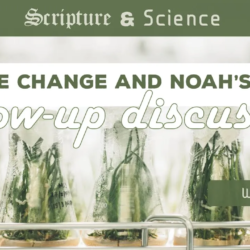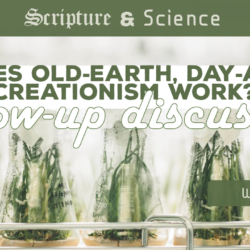So far we’ve considered physics and biology in our exploration of scripture and science. Today we begin to consider how earth science and the bible fit together. This becomes particularly significant when considering interpretations for Noah’s flood. We’ll get to that next time. But, for today, our teacher will lay out the basics of geology and earth science to give us a good overview. He’ll also cover radiometric dating, which has a bearing on how scientists determine the age of the earth.
Listen to this episode on Spotify or Apple Podcasts
See below for notes.
—— Links ——
- We are doing follow-up discussions to these episodes on YouTube. Check them out!
- See other episodes in this Scripture and Science Class
- Check out Barlow’s previous podcast episodes
- Learn more about and support the church Barlow and his team are starting in Louisville, KY, called Compass Christian Church
- Find more articles and audios by Barlow on his website: Study Driven Faith
- Support Restitutio by donating here
- Designate Restitutio as your charity of choice for Amazon purchases
- Join our Restitutio Facebook Group and follow Sean Finnegan on Twitter @RestitutioSF
- Leave a voice message via SpeakPipe with questions or comments and we may play them out on the air
- Intro music: Good Vibes by MBB Attribution-ShareAlike 3.0 Unported (CC BY-SA 3.0) Free Download / Stream: Music promoted by Audio Library.
- Who is Sean Finnegan? Read his bio here
—— Notes ——
Geology, Earth Science, and Atmospheric Science
• Geology
• Important cycles
• Plate tectonics
Geology
• Types of rocks/rock cycle
• Geological principles
• Dating methods
• Structure of the Earth
What is Geology?
Geology is the study of the Earth and the processes related to the Earth.
• Geologists study rocks (and the rock cycle)
• Subfields include atmospheric studies (meteorology), volcanology (studying volcanos), and mineralogy (study of minerals)
Types of Rocks
There are three major categories of rocks:
• Sedimentary – formed by pressure acting on sediment
• Igneous – formed by lava
• Metamorphic – formed by extreme pressure and heat
The Rock Cycle
Since wind and water are constantly affecting change, there is a rock cycle.
Geological Principles
There are several main principles of geology:
• Superposition
• Cross-cutting relationships
• Uniformitarianism
Dating Methods
There are major types of dating:
• Absolute dating
• Relative dating
Absolute Dating
Absolute dating is based on radioactive decay. What is radioactive decay?
• Some forms of certain elements are (by nature) unstable
• Over time, these elements change on the atomic level (sometimes losing protons and neutrons; sometimes exchanging protons and neutrons, etc.)
Carbon Dating
Carbon dating uses the decay of Carbon – 14
• Carbon – 12 has 6 neutrons and 6 protons
• Carbon – 13 has 7 neutrons and 6 protons
• Carbon – 14 has 8 neutrons and 6 protons
What happens when Carbon – 14 decays?
• Carbon – 14 exchanges a neutron for a proton
• This changes the element from carbon to nitrogen
• The reaction also produces an electron and an antineutrino
So, how does this tell us anything about dating?
• Radioactive decay is a process that is well understood
• The half-life for carbon – 14 is ~5,700 years
• This means, that it takes 5,700 years for the amount of carbon -14 in a sample to cut in half
Is carbon dating exact?
• No – it’s a statistical process
• However, there is a range of probable dates given
Relative Dating
What is relative dating?
• Relative dating uses the geological principles of superposition and cross-cutting relationships to provide estimates on how old certain features are
• Example: dating a rock layer based on the age of another layer (dated using radiometric dating)
Structure of the Earth
How do scientists know about the structure of the Earth?
• Scientists understand what waves do when they hit various materials (ex: ultrasound imaging)
• Seismological data from earthquakes has given us insight into the structure of the Earth
The Water Cycle
The water cycle is the process by which water goes through the phases of liquid, gas, and solid.
• The water cycle helps moderate temperatures on Earth
• The water cycle also supports life through crops and drinking water
Carbon and Nitrogen Cycles
Carbon and nitrogen also experience cycles of solid, liquid, and gas.
• The carbon cycle is important for the support of life.
• Disruption of the carbon cycle is one of the biggest fears of those promoting climate change.
Plate Tectonics
History of plate tectonics
• Ancients did not believe in tectonic separation
• In 1620, Sir Francis Bacon noted that Africa and South America looked like they could have fit together
• Similar animal fossils and other pieces of evidence started getting scientists’ attention
• In 1925, Alfred Wegener formally proposed plate tectonic theory and was ridiculed.
• In 1930, Wegener died while on expedition in Greenland, trying to find evidence for his theory.
• In the late 1960s, almost overnight, the theory of plate tectonics reached scientific mainstream.
Evidence for plate tectonics:
• Paleomagnetic data
• Similar rock outcroppings
• Fossil evidence
• Spreading of the sea floor
• Direct evidence – we can observe the movement!
Challenges to plate tectonics:
• Where is the energy coming from?
• Why are the continental plates moving like they are?
“Even today, many questions pertaining to plate tectonics remain unanswered. Many exceptions to rigid rules have been found throughout the world. Although classical plate tectonic theory works well for oceanic crust, it has a difficult time explaining the motion of the continents”
— Jon Erickson, Plate Tectonics, page 259.
Challenges for Geology
There are several concerns with geology as a science:
• The principle of uniformitarianism is impossible to prove and so it’s an assumption
• Relative dating techniques can use circular logic at times







The geological principle of superposition did seem so logical that it was a long-held assumption. However, when a way to actually test it was conceived, it turned out to be untrue except in very limited circumstances. See Lesson 1 on stratigraphy at this link: https://scripturalscrutiny.com/2017/04/06/294/
Another place where uniformatarianiism is shown totally inadequate is at Mt. Saint Helens. See Lesson 2 at this link: https://scripturalscrutiny.com/2017/04/06/294/
There are many questions in regard to plate tectonics theory. However, there is now evidence from physics and the internal structure of the earth that plate tectonics cannot happen as theorised. See part 6 of Lesson 8: Hydroplate Theory Overview which takes up plate tectonics in detail. https://scripturalscrutiny.com/2017/04/06/294/